Loud Rock at KGLT - playlist analysis and demographics
Ever since I began doing my radio show at KGLT, I've been collecting playlist data and coalescing it into a spreadsheet. I've been interested in analyzing that data to answer some questions about my listening and playing habits. Early on, I just didn't have enough data to evaluate, then life got busy and I didn't have time. Now that my steady show at KGLT is no longer, I wanted to analyze the data (over a year's worth) and see what it tells me.
I've often made the claim that a "lot" of the bands I listen to are from Finland and Sweden, however, I've never quantified that. That's one area I wanted to investigate using my KGLT playlist data. I also wanted to look at my data in the context of some of the "metal demographics" maps that are out on the web. They typically show Scandinavia, especially Finland and Sweden as contributing a disproportionate amount of metal to the world per capita (see Demographics of Metal). Of course, my analysis will only be one view of the problem, specific to the music I play at KGLT, but I still think it's interesting to analyze it in the context of the bigger picture.
My data is arranged to show every band I've ever played at KGLT and how many times I've played them. The simplest version of the spreadsheet sorts that data from most often played (#1 Nightwish, #2 Amaranthe) down to all the bands I've only played once. Right off the bat, I see hints of what I already suspected: in the top 10 most played bands, 3 are from Finland and 3 are from the United States. However, Sweden only has one band in the top 10. Looking at the top 20, Finland and Sweden each show up 4 times but the US is there 5 times. So, at the simplest level, yes, I do play a lot of Finnish and Swedish bands, but not at any obvious cost to the US.
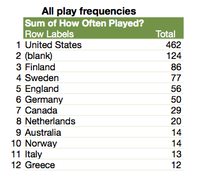 However, the US starts showing up in heavy numbers in slots 21 and below, quickly establishing a higher play count overall than even Sweden and Finland combined. In fact, the US swamps everyone else with 462 plays, with Finland the next closest at 86 and Sweden following at 77. That, however, feels a bit distorted to me. I'd spent many months reviewing the entire KGLT Loud Rock CD collection and had played any band that got my attention. That collection is fairly weak in imports, so the pool I had to pull from was a bit skewed against Finland and Sweden. Many of the bands during that library review period I only played once. With that in mind, I decided to trim down the data set and regenerate my charts. I ended up with charts just like the original except restricted to 3 or more plays, 6 or more plays and 8 or more plays. Only the most restrictive (8 or more plays) chart levels the tables, showing Finland in the #1 spot followed by the US and then Sweden, but all in comparable numbers. Clearly, when push comes to shove, the music I like to play the most is, in fact, biased towards Finland and Sweden.
However, the US starts showing up in heavy numbers in slots 21 and below, quickly establishing a higher play count overall than even Sweden and Finland combined. In fact, the US swamps everyone else with 462 plays, with Finland the next closest at 86 and Sweden following at 77. That, however, feels a bit distorted to me. I'd spent many months reviewing the entire KGLT Loud Rock CD collection and had played any band that got my attention. That collection is fairly weak in imports, so the pool I had to pull from was a bit skewed against Finland and Sweden. Many of the bands during that library review period I only played once. With that in mind, I decided to trim down the data set and regenerate my charts. I ended up with charts just like the original except restricted to 3 or more plays, 6 or more plays and 8 or more plays. Only the most restrictive (8 or more plays) chart levels the tables, showing Finland in the #1 spot followed by the US and then Sweden, but all in comparable numbers. Clearly, when push comes to shove, the music I like to play the most is, in fact, biased towards Finland and Sweden.
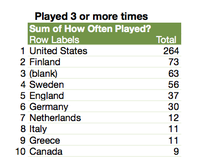 |
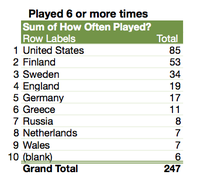 |
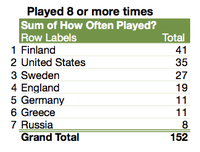 |
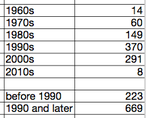 I also have claimed that I lean toward new music, playing lots of recent releases and bands from the 1990s and 2000s. To test those claims, I rearranged the data to look at number of plays per year the band was formed. I was pleased to see the 669 of the songs I played were from bands formed in 1990 or later. Only 223 of the plays are from bands formed prior to 1990. Being disappointed by the prevalence of "Classic Rock" stations and the dearth of new music on the radio, I was happy to see that I've been doing my part to reveal all the recently released heavy music out there in the world.
I also have claimed that I lean toward new music, playing lots of recent releases and bands from the 1990s and 2000s. To test those claims, I rearranged the data to look at number of plays per year the band was formed. I was pleased to see the 669 of the songs I played were from bands formed in 1990 or later. Only 223 of the plays are from bands formed prior to 1990. Being disappointed by the prevalence of "Classic Rock" stations and the dearth of new music on the radio, I was happy to see that I've been doing my part to reveal all the recently released heavy music out there in the world.
Having confirmed my suspicions at a very high level, I started to wonder how that relates to the population size that's generating these bands. I was highly suspicious that the main reason the US dominates the overall list is based on population size. I've seen the "metal demographics" maps and know how small the Swedish and Finnish populations are compared to the US. In addition, given my own knowledge of variation in metal style between states here in the US, and relative populations, I was curious about how things would change if I treated states as comparable to countries elsewhere in the world.
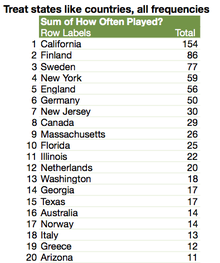 The first chart I generated considering states as countries showed something that won't shock anyone. The entity that generates the most plays on KGLT is California, immediately followed by Finland, Sweden and then the state of New York. Also, as no surprise to anyone, England and Germany land in the 5 and 6 slots. The next 10 are mostly states, including a number that I would have guessed (Massachusetts, Florida, Georgia and Texas). I don't know that I'd have guessed New Jersey and Illinois would be this high in the list, but Washington makes sense considering Seattle's contributions to music. Those of you outside the US will be pleased to see Canada at #8, the Netherlands at #12 and Australia at #16, immediately followed by Norway, Italy and Greece.
The first chart I generated considering states as countries showed something that won't shock anyone. The entity that generates the most plays on KGLT is California, immediately followed by Finland, Sweden and then the state of New York. Also, as no surprise to anyone, England and Germany land in the 5 and 6 slots. The next 10 are mostly states, including a number that I would have guessed (Massachusetts, Florida, Georgia and Texas). I don't know that I'd have guessed New Jersey and Illinois would be this high in the list, but Washington makes sense considering Seattle's contributions to music. Those of you outside the US will be pleased to see Canada at #8, the Netherlands at #12 and Australia at #16, immediately followed by Norway, Italy and Greece.
I was still a little surprised to see California dominating the list but once again remembered all those single-play bands from my library review efforts. We know that California, especially the southern part of the state, churns out a ton of bands, so it might still be simply the result of excess availability relative to imports. With that in mind, I decided to try looking at bands with higher numbers of plays. Even at 3 plays, the playing field levels quite a bit, with California leading at 88 but Finland in the same ballpark (73) and Sweden at 56. Being even more restrictive and looking at 5 plays or more pulls Finland into the lead at 63, with California at 61 and Sweden at 44.
 |
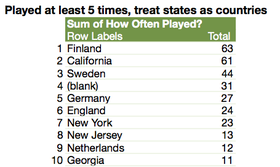 |
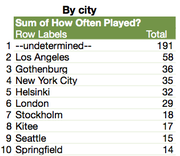 I also wanted to look at the cities spawning most of these bands. Now, at this point my data is a little less robust, since the Wikipedia, where I gathered band information, is a bit spotty on how it describes where bands are from. Places like New York City and Los Angeles often are credited for bands that were formed in a borough or nearby city. Even so, I think the table is interesting, keeping in mind that Los Angeles and New York City probably have higher numbers than reality. It's definitely interesting to see Gothenburg as contributing the second largest number of plays and Helsinki in the #4 spot (note I'm skipping the true #1 in the list which is "undetermined").
I also wanted to look at the cities spawning most of these bands. Now, at this point my data is a little less robust, since the Wikipedia, where I gathered band information, is a bit spotty on how it describes where bands are from. Places like New York City and Los Angeles often are credited for bands that were formed in a borough or nearby city. Even so, I think the table is interesting, keeping in mind that Los Angeles and New York City probably have higher numbers than reality. It's definitely interesting to see Gothenburg as contributing the second largest number of plays and Helsinki in the #4 spot (note I'm skipping the true #1 in the list which is "undetermined").
With all those questions answered, I still had a nagging curiosity. How much do the large populations of California, Germany and England help them generate large numbers of playable bands (for my show). So, I made one more table, scaling the number of plays by the population of the state or country.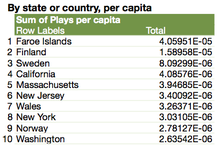 It's impressive that California has so many plays that it still lands in the #4 spot despite its large population. Sure enough, Finland and Sweden, with their smaller populations and large number of plays land in the #2 and #3 spots, but what about #1? I had to laugh when I saw it. I love Tyr and a played them a number of times, but they had never generated an entry anywhere near the top of my tables before this. Thanks to the tiny population of the Faroe Islands, however, it lands in the #1 slot. Basically, I can conclude that the Faroe Islands, per capita, are the most effective country for generating music I like to play on the radio. Go Faroes and Go Tyr!!
It's impressive that California has so many plays that it still lands in the #4 spot despite its large population. Sure enough, Finland and Sweden, with their smaller populations and large number of plays land in the #2 and #3 spots, but what about #1? I had to laugh when I saw it. I love Tyr and a played them a number of times, but they had never generated an entry anywhere near the top of my tables before this. Thanks to the tiny population of the Faroe Islands, however, it lands in the #1 slot. Basically, I can conclude that the Faroe Islands, per capita, are the most effective country for generating music I like to play on the radio. Go Faroes and Go Tyr!!
In the end, the data simply reinforces what I already know. I love Finnish and Swedish metal. Those two countries are highly efficient at creating new bands that I like, and at the same time generate a wide variety of sub-styles within the metal umbrella. The United States and California, where I was born and raised, clearly generate a ton of listenable heavy music, and I should not overlook many parts of the US for their contributions to the overall metal pool. Sadly, Montana does not even appear in the data. Perhaps I can take small solace in knowing that Oregon does not appear in the data either, and Portland is currently a lively music center. So there's always a chance I just didn't get around to playing that one metal gem from Montana.
 2 Comments → Posted on
2 Comments → Posted on  Wednesday, October 3, 2012 at 5:36PM
Wednesday, October 3, 2012 at 5:36PM  California,
California,  Finland,
Finland,  KGLT,
KGLT,  New York,
New York,  Sweden,
Sweden,  United States,
United States,  data analysis,
data analysis,  demographics,
demographics,  loud rock,
loud rock,  metal,
metal,  playlist,
playlist,  radio | in
radio | in  Analysis,
Analysis,  Demographics,
Demographics,  Radio
Radio